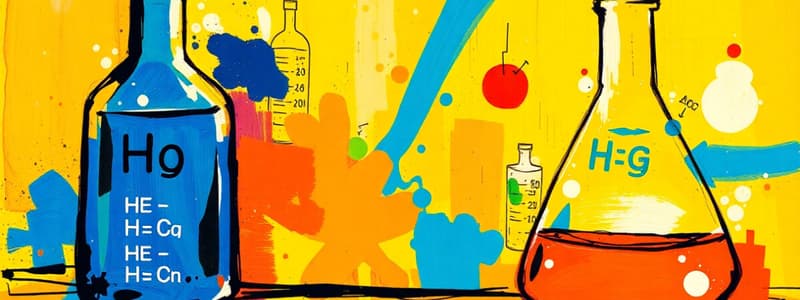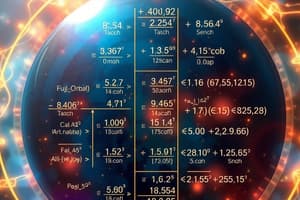Podcast
Questions and Answers
How is the concentration of hydroxide ions ($OH^-$) determined from the equation $OH^- : N_1 V_1 = N_2 V_2$?
How is the concentration of hydroxide ions ($OH^-$) determined from the equation $OH^- : N_1 V_1 = N_2 V_2$?
The concentration of $OH^-$ is calculated using the equation by substituting known values for $N_2$ and $V_2$, allowing us to solve for $N_1$.
What value is approximated for $OH^-$ after calculating $
rac{1}{20} imes(2.7)$?
What value is approximated for $OH^-$ after calculating $ rac{1}{20} imes(2.7)$?
The value approximated for $OH^-$ is 0.01.
Using the formula given, how do you calculate the strength of carbonate ions ($CO_3^{2-}$) in parts per million (PPM)?
Using the formula given, how do you calculate the strength of carbonate ions ($CO_3^{2-}$) in parts per million (PPM)?
The strength of $CO_3^{2-}$ is calculated as $0.05 imes 30 imes 1000 = 1500$ PPM.
What role do the variables $N_1$, $V_1$, $N_2$, and $V_2$ play in the provided calculations?
What role do the variables $N_1$, $V_1$, $N_2$, and $V_2$ play in the provided calculations?
Why might one use the approximation in calculations such as those for $OH^-$ and $CO_3^{2-}$?
Why might one use the approximation in calculations such as those for $OH^-$ and $CO_3^{2-}$?
Flashcards
What is the formula for calculating the concentration of OH⁻?
What is the formula for calculating the concentration of OH⁻?
The formula for calculating the concentration of hydroxide ions (OH⁻) is based on the principle of equivalence: N₁V₁ = N₂V₂. In this context, N₁ and N₂ represent the normalities (concentrations) of the solutions, while V₁ and V₂ symbolize the volumes used.
How is V₁ calculated in the OH⁻ formula?
How is V₁ calculated in the OH⁻ formula?
V₁ (the volume of the OH⁻ solution) is calculated using the equation: V₁ = (N₂V₂)/(V₁). Where N₂ represents the normality of the standard solution, V₂ represents the volume of the standard solution used in titration, and (P-M) represents the difference in volume readings from the burette.
How is the concentration of CO₃⁻² determined?
How is the concentration of CO₃⁻² determined?
The concentration of carbonate ions (CO₃⁻²) is determined using the same equivalence principle: N₁V₁ = N₂V₂. The concentration of CO₃⁻² is then calculated multiplying its normality by the equivalent weight (30 for CO₃⁻²) and by 1000 to convert to parts per million (PPM).
What is the significance of N₁V₁ = N₂V₂?
What is the significance of N₁V₁ = N₂V₂?
Signup and view all the flashcards
What is the relationship between normality and PPM?
What is the relationship between normality and PPM?
Signup and view all the flashcards
Study Notes
Calculations for OH⁻ and CO₃²⁻ Strength
-
OH⁻ Strength Calculation:
- Formula used: N₁V₁ = N₂V₂ where N is the normality and V is the volume
- N₁ = 1/20 (Normality of OH⁻)
- V₁ = 10 mL
- Calculated strength: 0.01
- Expressed as parts per million (PPM)
-
CO₃²⁻ Strength Calculation:
- Formula used: N₁V₁ = N₂V₂
- N₁= 1/20 (Normality of CO₃²⁻)
- V₁ = 10 mL
- V₂ = 2 mL
- Calculated strength : 0.05
- Expressed as parts per million (PPM)
Studying That Suits You
Use AI to generate personalized quizzes and flashcards to suit your learning preferences.
Description
This quiz will test your understanding of the calculations related to the strength of hydroxide (OH⁻) and carbonate (CO₃²⁻) ions. You will encounter normality and volume relationships using the formula N₁V₁ = N₂V₂. Prepare to apply your knowledge of chemical concentrations and unit conversions in a series of questions.




